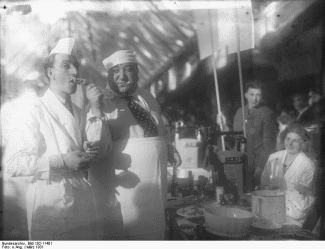by Wikipedia
December 19, 2014
NOTICE: THIS WORK MAY BE PROTECTED BY COPYRIGHT
YOU ARE REQUIRED TO READ THE COPYRIGHT NOTICE AT THIS LINK BEFORE YOU READ THE FOLLOWING WORK, THAT IS AVAILABLE SOLELY FOR PRIVATE STUDY, SCHOLARSHIP OR RESEARCH PURSUANT TO 17 U.S.C. SECTION 107 AND 108. IN
THE EVENT THAT THE LIBRARY DETERMINES THAT UNLAWFUL COPYING OF THIS WORK HAS OCCURRED, THE LIBRARY HAS THE RIGHT TO BLOCK THE I.P. ADDRESS AT WHICH THE UNLAWFUL COPYING APPEARED TO HAVE OCCURRED. THANK YOU FOR RESPECTING THE RIGHTS OF COPYRIGHT OWNERS.
Hans Günther (22 August 1910 - 5 May 1945) was an SS-Sturmbannführer who was the head of the "Central Office for Jewish Emigration in Prague" during World War II. He was in charge of the deportation of Czech Jews to death camps during the Holocaust. He was killed by Czech partisans in 1945.
Career
Günther worked as an accountant until 1931. He joined the Sturmabteilung (SA) in November 1928, rising quickly to become SA leader in March 1929. From April 1931 he was a member of the Freiwilligen Arbeitsdienstes volunteer service, which he headed from 1932 to 1933. From September 1935 Günther was employed by the Gestapo as a detective in Erfurt, where he became responsible with his brother Rolf Günther for issues related to the so-called "Jewish question". After 1937 Günther and his brother joined the "Central Office for Jewish Emigration in Vienna". While his brother Rolf later worked under Adolf Eichmann in the Reich Security Main Office as deputy director of the "Jewish Department", Hans was promoted in July 1939 to head of the "Central Office for Jewish Emigration" in Prague (later renamed the "Central Office for the Settlement of the Jewish Question"). He remained in the post until early May 1945. His role was to organise the "final solution" in Prague, and was given instructions concerning the true meaning of this by Eichmann and Reinhard Heydrich. His responsibilities were the maintenance of anti-Jewish regulations in the Protectorate of Bohemia and Moravia, as well as deportations of Czech Jews to the ghetto in Theresienstadt and from there to the extermination camps. The prisoners in the camp called him the "smiling executioner".[1]
Theresienstadt film
In order to counter Allied propaganda about the concentration camps Günther commissioned a film, "Theresienstadt", about the "Jewish area of settlement", portraying an idealised image of well-fed and housed Jews.[2] The film was made during the late summer of 1944 and completed in March 1945. Kurt Gerron, a Jewish actor/director, made the film in return for a promise that he and his family would live. Shortly after he finished shooting the film, however, both he and his family were "evacuated" to Auschwitz where they were gassed upon arrival.

Comedy duo Sig Arno and Kurt Gerron, Berlin 1931
The film was intended for foreign audiences, but as it was completed shortly before the collapse of the Third Reich, it was only seen by a few representatives of foreign organizations. Günther also set up a museum of Jewish artefacts in Prague containing items from destroyed synagogues.[3]
Death
In May 1945, when the Prague uprising broke out, Günther, travelling with a heavily armed motorcade, was stopped at a roadblock near Beroun by Czech partisans. He was arrested and disarmed. According to the partisans, he attempted to grab a weapon from a guard and was mortally wounded in the ensuing struggle when he was injured by a hand-grenade; he later died from his injuries. The Czech authorities later accepted this account of his death, which was given to the German judicial authorities.[1]
References
1. Ernst Klee: Das Personenlexikon zum Dritten Reich: Wer war was vor und nach 1945. Fischer-Taschenbuch-Verlag, Frankfurt am Main 2005. ISBN 3-596-16048-0
2. Bred Prager, "Interpreting the Visible Traces of Theresienstadt", Journal of Modern Jewish Studies, 7:2, 175-194, 2008, p.178.
3. Jan Björn Potthast: Das jüdische Zentralmuseum der SS in Prag – Gegenerforschung und Völkermord im Nationalsozialismus. Campus-Verlag, München 2002 ISBN 3-593-37060-3
